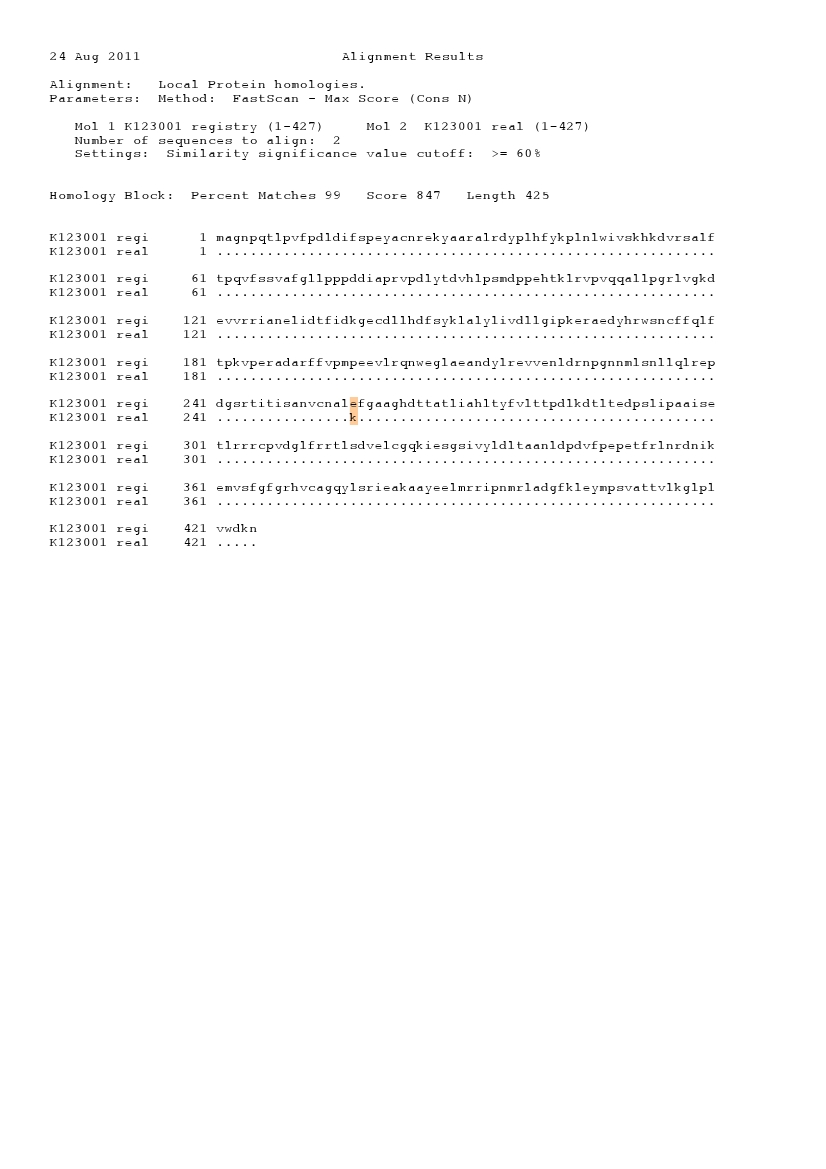Team:Bielefeld-Germany/Results
From 2011.igem.org
| Line 5: | Line 5: | ||
==Sequencing results== | ==Sequencing results== | ||
| - | The iGEM team from the University of Alberta sent in BioBricks for BPA degradation in 2008 (<partinfo>K123000</partinfo> and <partinfo>K123001</partinfo>). Sequencing of these BioBricks by the iGEM HQ and by us led to negative results so the sequences entered into the partsregistry are not correct although these sequences are the ones from ''Sphingomonas bisphenolicum'' AO1 (compare [http://www.ncbi.nlm.nih.gov/nuccore/AB255167.1 genbank entry]). In addition, there are "illegal" AgeI and NgoMIV restriction sites in the BioBrick which are used for Freiburg BioBrick assembly standard (RFC 25). After translating and comparing the original sequences from the partsregistry and the sequences from our sequencing results ''in silico'' we saw, that the amino acid sequences were identically. These BioBricks were probably synthesized in the Freiburg assembly standard 25 because they have the accordant restriction sites and they were codon optimized for ''Escherichia coli'' but the original sequence from ''S. bisphenolicum'' AO1 were entered into the registry because amino acid sequence of the real sequence and the sequence that was entered are identical. | + | The iGEM team from the University of Alberta sent in BioBricks for BPA degradation in 2008 (<partinfo>K123000</partinfo> and <partinfo>K123001</partinfo>). Sequencing of these BioBricks by the iGEM HQ and by us led to negative results so the sequences entered into the partsregistry are not correct although these sequences are the ones from ''Sphingomonas bisphenolicum'' AO1 (compare [http://www.ncbi.nlm.nih.gov/nuccore/AB255167.1 genbank entry]). In addition, there are "illegal" AgeI and NgoMIV restriction sites in the BioBrick which are used for Freiburg BioBrick assembly standard (RFC 25). After translating and comparing the original sequences from the partsregistry and the sequences from our sequencing results ''in silico'' we saw, that the amino acid sequences were identically. These BioBricks were probably synthesized in the Freiburg assembly standard 25 because they have the accordant restriction sites and they were codon optimized for ''Escherichia coli'' but the original sequence from ''S. bisphenolicum'' AO1 were entered into the registry because amino acid sequence of the real sequence and the sequence that was entered are identical. The alignments are shown in fig. 1 - 4. |
| + | |||
| + | <center><gallery perrow=4> | ||
| + | |||
| + | Image:Bielefeld2011_K123000_DNA.jpg|Fig. 1: Alignment of the DNA sequence of <partinfo>K123000</partinfo> entered into the partsregistry (K123000 registry) with our sequencing results (K123000 real) for this BioBrick (made with Clonemanager). | ||
| + | Image:Bielefeld2011_K123000_AA.jpg|Fig. 2: Alignment of the aminoacid sequence (translated ''in silico'') of <partinfo>K123000</partinfo> entered into the partsregistry (K123000 registry) with our sequencing results (K123000 real) for this BioBrick (made with Clonemanager). | ||
| + | Image:Bielefeld2011_K123001_DNA.jpg|Fig. 3: Alignment of the DNA sequence of <partinfo>K123001</partinfo> entered into the partsregistry (K123001 registry) with our sequencing results (K123001 real) for this BioBrick (made with Clonemanager). | ||
| + | Image:Bielefeld2011_K123001_AA.jpg| Fig. 4: Alignment of the aminoacid sequence (translated ''in silico'') of <partinfo>K123001</partinfo> entered into the partsregistry (K123001 registry) with our sequencing results (K123001 real) for this BioBrick (made with Clonemanager). | ||
| + | |||
| + | |||
| + | </gallery></center> | ||
| + | |||
==Bisphenol A degradation with ''E. coli''== | ==Bisphenol A degradation with ''E. coli''== | ||
Revision as of 11:42, 17 September 2011

Contents |
Bisphenol A degradation
Sequencing results
The iGEM team from the University of Alberta sent in BioBricks for BPA degradation in 2008 (<partinfo>K123000</partinfo> and <partinfo>K123001</partinfo>). Sequencing of these BioBricks by the iGEM HQ and by us led to negative results so the sequences entered into the partsregistry are not correct although these sequences are the ones from Sphingomonas bisphenolicum AO1 (compare [http://www.ncbi.nlm.nih.gov/nuccore/AB255167.1 genbank entry]). In addition, there are "illegal" AgeI and NgoMIV restriction sites in the BioBrick which are used for Freiburg BioBrick assembly standard (RFC 25). After translating and comparing the original sequences from the partsregistry and the sequences from our sequencing results in silico we saw, that the amino acid sequences were identically. These BioBricks were probably synthesized in the Freiburg assembly standard 25 because they have the accordant restriction sites and they were codon optimized for Escherichia coli but the original sequence from S. bisphenolicum AO1 were entered into the registry because amino acid sequence of the real sequence and the sequence that was entered are identical. The alignments are shown in fig. 1 - 4.
 "
"




